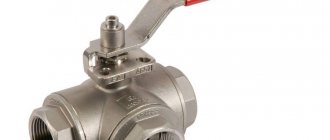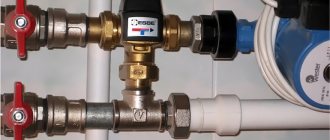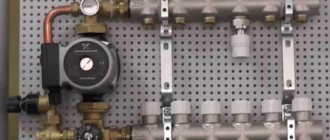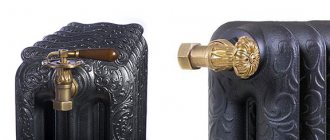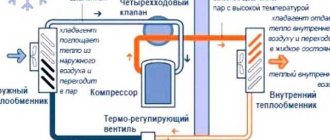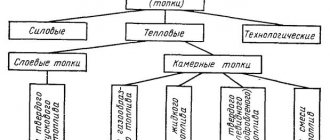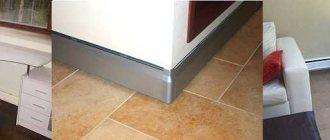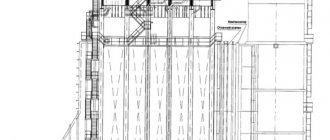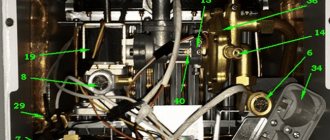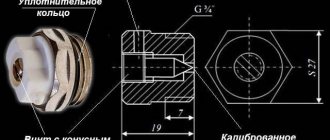Even the most minor disruptions in the operation of utilities can potentially develop into acute problems and, as a result, cause serious discomfort for all household members. That is why prudent owners try their best to prevent such inconveniences by installing various kinds of auxiliary devices in their homes. One of them is a bypass, which is actively used in heating and water supply systems. We will talk about it further: let’s figure out what kind of device this is, what are the principles of its operation, what are its advantages and why it is needed. And finally, we’ll tell you and show a video of how to install a bypass valve with your own hands.
Design and principle of operation
Structurally, the bypass is a jumper pipe with shut-off and control valves.
Its main task is to create a parallel flow of working fluid bypassing a specific device in the engineering system. In other words, the bypass creates a bypass line. The principle of operation of the device is extremely simple: during normal operation of the heating or water supply system, the jumper freely allows the flow of liquid through it, but as soon as this flow needs to be limited, the bypass shut-off element closes and the liquid begins to bypass a certain section of the system. Such blocking is possible due to the difference in diameters of the bypass itself and the supply pipe - the first is always smaller than the second.
Bypass placement
Using a bypass has many advantages. Firstly, the maintenance of heating and water supply systems is significantly simplified. Secondly, with a large number of heating batteries, the overall efficiency of the system increases and energy consumption decreases. Thirdly, the problem of air in pipes and batteries due to their depressurization disappears. Fourthly, it becomes possible to use the equipment even in abnormal and emergency situations. How do all these benefits become a reality? Let's find out by getting acquainted with the features of using jumpers in different engineering systems. But before that, let’s find out what modern bypasses are.
Why do you need a bypass?
The bypass is used as a backup path, which is required for the reliable operation of engineering systems in the event of an emergency or for repair work.
It applies:
- during the construction of oil and gas pipelines;
- in systems pumping various liquids, including milk and gasoline;
- in central power supply structures;
- in water supply and sanitation;
- in heating systems, etc.
Bypass piping system
The use of bypass in water supply
Gas distribution cabinet with bypass
Water supply bypass (for filtration unit)
Bypasses in the central heating riser
Bypass in a drip irrigation system
A bypass is a parallel pipeline branch installed at key points in the circuit. This section of a backup pipe, which has shut-off and control valves, is intended to drain the transported medium from the main pipeline and supply it into it (SNiP I-2). The main purpose of the design is to create a parallel flow of working fluid, bypassing any section of communications.
Reserve pipeline
In water supply systems, as in other structures, when emergency situations arise, there is a need to direct water moving under pressure along a backup path, blocking the emergency route.
- One of the tasks of a bypass in water supply systems is the ability to use a backup pipeline to remove an individual water flow meter that needs verification or repair. There is no need to turn off the water. This is especially important in boiler rooms or medical institutions where a constant water supply is necessary.
On a note! The locking device on the bypass branch must be sealed when closed (SP 30.13330).
- The bypass circuit is used in the piping scheme of the pool water treatment unit.
Pool water treatment unit
General reserve pipeline
Common bypass and bypass to universal filter
- A bypass is also installed on filtration systems, which allows for scheduled or emergency maintenance of equipment without shutting off the water supply to the building. The bypass line can be installed both on the entire filter system and on a specific module.
- You cannot do without a bypass in systems with installed pumps for supplying water cooling reactors or blast furnaces, when the pumps cannot be turned off for repairs. The emergency section is closed by turning on the pump on a parallel branch, which ensures the continuity of the production process.
- In water heating systems equipped with circular pumps, failures due to power outages are not uncommon. Using a bypass, you can organize natural circulation of water by blocking its access to the pump and running it through the central heating pipe.
Bypass with circulation pump
- Using a bypass pipe, you can, if necessary, regulate the volume of hot water acting as a coolant, thereby establishing the required temperature in the room and reducing heating costs.
- The bypass also allows you to replace the radiator if it breaks without turning off the heating in the house. The same role is played by the jumper installed in front of the heated towel rail - it ensures the direction of the flow of hot water bypassing it for repairs or the ability to maintain the required temperature of the coolant in the device.
Jumper installed in front of the heated towel rail
Types of bypasses
Bypasses are classified according to two criteria:
- type of shut-off valves;
- appointment.
Based on the first feature, two types of bypasses are distinguished:
- With a tap. A mechanical version of the bypass, which is controlled by manually opening and closing the tap. The latter, as a rule, is located in the center of the jumper pipe. Bypasses can be equipped with two types of valves: ball and three-way. They differ from each other only in design, but the principle of operation of both cranes is almost the same.
Types of bypasses - With valve. Automatic bypass that operates in autonomous mode and does not require adjustment by the user. The valve is a rubber ball of increased buoyancy. This bypass is used in conjunction with a circulation pump: when it is turned on, the valve under pressure opens the path for the medium, and when turned off, it automatically closes.
Important! An automatic bypass with a valve can only be installed in those heating and water supply systems where only clean media are used - scale, scale, rust and other dirty impurities if they get on the valve can cause its deformation, as a result of which the locking mechanism will no longer close completely.
Based on their purpose, bypasses are divided into:
- radiator - installed on the approaches to heating radiators and used to turn them off if necessary;
- pumping - mounted together with pumps and used either to change their operating mode or to completely shut down;
Bypass features
Bypasses have some features:
- When installing a bypass, you need to pay attention to the diameter of the unit. It must be smaller than the diameter of the supply pipeline;
- For the bypass device, it is best to use American nuts. They allow you to quickly disassemble the valves and pump in case of any repairs;
- In order to avoid airing in the system, the unit can only be installed horizontally;
- It is necessary to install plugs at the top and bottom of the pipe;
- The knot can be made by hand. To do this, you need to purchase a tee, a piece of pipe and a welding machine. But you can also buy ready-made elements and assemble them using threaded contacts;
- It is necessary to install a thermostat or control valve between the bypass and battery inlet holes;
- The bypass should be installed next to the radiator, but away from the riser. The most suitable place will be where the temperature is not very high. Also, the service life of the bypass will decrease if it is installed next to a heating boiler;
- A special coupling must be installed on the bypass pipe. This is necessary for its easy removal along the thread during repairs.
If you cannot install the bypass yourself, you can invite a specialist. If you install the bypass correctly, you will notice significant benefits.
Even the most minor disruptions in the operation of utilities can potentially develop into acute problems and, as a result, cause serious discomfort for all household members. That is why prudent owners try their best to prevent such inconveniences by installing various kinds of auxiliary devices in their homes. One of them is a bypass, which is actively used in systems and. We will talk about it further: let’s figure out what kind of device this is, what are the principles of its operation, what are its advantages and why it is needed. And finally, we’ll tell you and show a video of how to install a bypass valve with your own hands.
Features of application
Most often, bypasses are used for the following purposes:
- Maintenance of individual devices without stopping the entire system. If for some reason you need to remove equipment in the heating system or on the water supply line, for example, to repair or replace it, you should simply close the inlet and outlet valves of the working medium and then the liquid will flow through the bypass, and you can dismantle the necessary device without consequences .
Bypass in the heating system
- Improving the operation of a single-pipe heating circuit. The main disadvantage of a single-pipe system is the uneven distribution of the coolant: since the batteries here are connected in series, as it moves, the working fluid cools down and the last devices receive almost cold coolant. To avoid this, a bypass is installed in front of each radiator - thanks to it, a certain part of the media moves around the batteries and, as a result, reaches hot water even to a distant device.
Advice. In a similar way, you can regulate the heat transfer of radiators in a two-pipe system - just turn off the tap in the selected location, and the hot medium will move to those areas that really need heating.
- Maintaining the heating system without power supply. If the system uses an electric pump, then it is logical that if the power supply is turned off, it will stop working and stop the heating process. But the bypass will also save you in this situation: by turning off the pump supply valve and allowing the media to flow through the jumper, you can activate the natural circulation of the liquid and restore the system’s functionality.
Bypass as a heating radiator piping element
Why is a radiator bypass required?
To understand the meaning of the installed jumper on the battery, you need to imagine how the heating system works in a multi-story building. And it is most often organized according to the one-pipe principle - this is both cheaper and easier to implement.
The idea is that the radiators are located in series on one pipe. The supply and return collectors are usually located in the basement of the house, where a heating station with an elevator unit is organized. A riser will rise up from the supply manifold. There are two possible options here. In the first, the riser rises to the highest point, and from there the coolant descends down the pipe on which all the radiators are located, from the top to the bottom floor (this is called a top-feed riser). A slightly different scheme is also used, with the so-called bottom supply, when already on the way up the coolant begins to give off heat to successively located radiators, and then also on the way back. In any case, this ring closes on the return manifold. Both of these schemes are clearly shown in the illustration below.
Schemes of single-pipe wiring in a multi-storey building: on the left - with the upper coolant supply, on the right - with the lower one. There are no bypasses on the radiators, and the system is extremely vulnerable
ANY fails . Disabling the emergency device immediately interrupts the entire circuit and it becomes inoperable. And to remove the battery you will also need to completely drain the water from the entire riser.
And the problem is solved very simply - each of the radiators installed in such a circuit must have a jumper between the supply pipes, not far from the tie-in points - the same bypass. The scheme remains virtually unchanged, but its “survivability” increases sharply.
If there are bypasses on the radiators of a single-pipe heating system, then dismantling or even simply turning off any of the devices has virtually no effect on the operation of the others
As a rule, the radiator is now installed with shut-off valves with union nuts installed in front of them. That is, it is not at all difficult to turn off the battery by turning off both taps, and then dismantle it for repair, replacement, maintenance, etc. The flow of coolant will not be interrupted, since there is a “workaround”, that is, a bypass.
But this is not all the advantages that a bypass provides in the heating distribution of an apartment building. Central systems do not respond quickly to changes in weather conditions, so it is often thawed outside, and the batteries heat up as if in severe frost. And the intense heat indoors in winter is, you see, also very uncomfortable. In addition, a phenomenon characteristic of single-pipe systems is observed when the temperature in the radiators at the beginning of the circuit along the flow of the coolant is noticeably higher than in those located closer to the end. In a word, the ability to independently regulate the heating level of the batteries is very important, preferably according to the thermostatic principle.
The presence of a thermostatic regulator allows you to automatically maintain the set temperature in the room. Temperature. But you can’t do without a bypass here either.
This is all quite doable - it is possible to purchase and independently install relatively inexpensive and very effective thermal valves with thermostatic heads. They are installed at the coolant supply to the battery and quantitatively regulate the hot flow passing through it.
Bypass prices
bypass
The way to maximum comfort is to install thermostatic regulators on your radiators!
Compact and easy-to-use devices are able to maintain the temperature in the room that the owners consider most comfortable for themselves. thermostats for heating radiators work , how you can install and configure them yourself - read in a special publication on our portal.
But quantitative temperature control on one radiator, that is, reducing the amount of coolant passing through the valve, can affect the operation of others located after it in a single-pipe “chain”. Moreover, this will affect both the temperature and pressure in the system. What if there are several such regulators in the circuit? – by the end of the riser, complete “discord” in the system parameters is possible! It is unlikely that any of the neighbors next door will like this situation.
But this, again, is if bypasses are not installed. And with jumpers, all the negativity goes away completely. The excess pressure that arises in front of the half-closed thermal valve is simply released through the bypass, the temperature in the pipe remains practically unchanged (even, perhaps, it will be higher than without the use of thermostats). And it is easier for the adjustment devices themselves to work in such conditions - there is less wear, since the effect of increased pressure on the valve seals is not so high.
The logical conclusion is that in a single-pipe wiring of a multi-storey building, the bypass becomes not a desirable, but a mandatory element of the radiator piping. And if for some reason it is not there, then you need to take care of it in order to eliminate the deficiency.
And if the system in the house is two-pipe, is a bypass needed?
No, in this case the jumper will no longer play any role. All radiators are installed independently, and disconnecting any of them, or installing control equipment on it, will in no way affect the performance of the remaining devices in the system.
With a two-pipe wiring, a bypass on the heating radiator may only be needed when using high-quality temperature control devices - three-way thermal valves, but this is not often practiced, since it is not economically justified
The only exception in this case can be considered a bypass, which is installed to qualitatively regulate the temperature in the radiator, using a three-way valve, when the cooled coolant from the “return” is mixed with the incoming flow from the supply pipe. However, such a scheme is used infrequently, because for a single radiator quantitative adjustment with a cheaper conventional thermal valve is quite sufficient.
So, in a two-pipe installation, a bypass is not required, but you should make sure that you have a two-pipe system in your apartment. The fact is that sometimes the presence of two risers running along the wall can be misleading. It is important to note a fundamental difference here.
It seems similar, but in reality these are completely different systems for connecting radiators
Pay attention to the illustration. On the right is shown a truly two-pipe system - the radiator inlets are connected to completely different risers. In such a situation, there is no need for a bypass, that is, everything is shown correctly in the picture.
But on the left fragment there also seem to be two pipes. However, the heating radiator is embedded in the gap of only one of them, and the second passes “intact”. It is just a riser to ensure the upper supply of coolant, the diagram of which was discussed above. But the system itself remains one-pipe, and there is no way to do without a bypass.
Above we were talking about apartments in high-rise buildings. But what about the owners of their own houses with an autonomous heating system?
The principle is the same. A more expensive (in terms of pipe consumption during installation) and “obedient” two-pipe system will not require a bypass. But often, for reasons of practicality, single-pipe circuits are also used - a prime example of this is the popular “Leningradka”. Of course, no one will blame the home owner for not installing a bypass on his radiators, but common sense dictates that it is still worth doing. Why complicate your life if it is possible to make each heat exchange device independent, and its individual settings have little effect on the operation of the remaining batteries. Such a measure will minimize another negative quality of the “one-pipe” system, when the temperature in radiators standing in series gradually decreases as they move away from the boiler.
By the way, in a single-pipe heating system used for distribution to one level (floor), the possibility of having a bypass, so to speak, by default, is already structurally incorporated. In the same “Leningrad”, its role will be successfully fulfilled by the distribution pipe itself.
The radiators are embedded according to the Leningradka pattern. Why not bypasses below, along the distribution pipe line?
By the way, it is in this case that the bypass can be made controllable - this will be discussed below.
What is the Leningradka heating system?
This system has gained wide popularity for its relative ease of installation and cost-effectiveness in terms of material consumption. At the same time, it remains very effective in operation. about the design of the Leningradka heating system , its debugging and the possibilities of modernization in a special publication on our portal.
Video: Why is a bypass on a heating radiator necessary?
How to install a bypass on a heating radiator yourself?
Basic rules for installing a bypass in a battery harness
For the purposes of this publication, it is not intended to teach the reader the techniques of plumbing installation. The vast majority of owners of houses or apartments have encountered these issues to one degree or another and have developed certain work skills. Surely, many have already developed their own favorite approaches to performing plumbing installation operations - be it soldering polypropylene pipes, threaded assembly or welding of metal products, or the use of connecting fittings, for example, when working with metal-plastic. Therefore, below we will only describe the basic rules that must be followed when installing a bypass on a heating radiator, and provide several illustrative examples of such assemblies.
So, installing a bypass on a heating battery in an apartment building must obey the following rules:
The simplest diagram for installing a bypass in a radiator piping on a vertical heating riser of a single-pipe high-rise building system
- The presence of shut-off and control valves in the area from the riser to the bypass itself must be completely excluded. This reduces the likelihood of even accidentally shutting off the main heating circuit to zero.
- The position of the bypass when piping a radiator connected to a vertical riser also matters. It is necessary to try to place the jumper as far as possible from the main pipe and, accordingly, as close as possible to the battery itself. It is clear that aesthetic considerations often begin to have an influence, but the bypass can be made unnoticeable. Of course, when choosing a specific installation location, it is also necessary to take into account areas for installing ball valves that cut off the radiator, or thermostatic devices, if you plan to use them. But it’s worth emphasizing once again - all these elements can only be installed in the area between the bypass and the battery, but not in front of it!
- Now about the ratio of the diameters of the pipes used for piping the radiator. Ideally, it should correspond to the following “canon” (see diagram above):
— DN1 is the diameter of the nominal diameter of the heating riser pipe. It remains unchanged up to the tee into which the bypass will be installed.
— DN2 is the diameter of the supply pipes to the radiator, from the tee to the battery itself. According to the rules, it should be one size smaller than the riser.
— DN3 – bypass diameter. It is one size smaller than the supply pipes and, accordingly, two smaller than the riser pipes.
It is these proportions that determine the correct operation of an uncontrolled bypass, that is, one that does not require user intervention. At the tee, the flow of circulating coolant will be divided into the main one, towards the radiator (where it can later be regulated by a thermostatic valve), and a bypass flow, through the bypass. If there is thermostatic equipment, then excess coolant will be discharged through the bypass, thereby avoiding the creation of zones of excessive pressure and vacuum.
If the radiator is tied with horizontal pipe routing (in the same “Leningrad”), then for the correct operation of the uncontrolled bypass, slightly different ratios are practiced.
Prices for thermal heads
thermal heads
Standard for piping a heating radiator for horizontal wiring of a single-pipe system
In this case, the section of the wiring itself, limited by the tees from which the liner goes to the radiator, acts as a bypass. This section should be 1 size smaller than the main line, and the supply pipes should be two sizes smaller.
- The next most important question is whether a shut-off or control valve is necessary on the bypass itself?
Following the logic of things, such a tap clearly suggests itself, since it can well be used as a flow regulator through a radiator. However, not everything is so simple.
For residents of apartment buildings, such a measure is regarded as gross unauthorized interference in the operation of the heating system. Judge for yourself - even an accidental overlap of these jumpers in individual apartments will certainly affect others, that is, the overall balance of the circuit serving the riser will be disrupted. Claims may arise against the work of the heat energy supplier, and the specialists of this organization, experienced in their field, will certainly find the culprit when dealing with complaints. Let everyone evaluate the consequences of such proceedings for themselves, but conflicts with neighbors are the least that can happen.
But installing a thermostatic regulator in the presence of a normal bypass is the right decision that should suit everyone.
So, the conclusion: the presence of a tap on the bypass in an apartment building should be completely excluded, since even the slightest possibility of accidental imbalance of the riser cannot be allowed. Those photographs shown on the Internet in which the bypass is equipped with a tap are an example of a gross violation of the rules.
Do not give in to the persuasion of “experienced craftsmen” - there should not be a bypass valve in the radiator piping in a multi-story building!
It’s a different matter if we are talking about a single-pipe heating system for your own home. Here the owners are free to experiment as they please. Indeed, control taps are often installed on the bypass in Leningradka, which allow both adjusting the operation of a particular radiator and balancing the system or some part of it. In this case, you don’t even have to strictly adhere to the recommended differences in pipe diameter. But the valve, of course, should not be a ball valve (such valves should not be used for adjustments at all - their two normal positions are: completely open or closed). It is practiced to install needle valves, which allow adjustment with very high accuracy. You can also install an adjusting tap block - it is more convenient from the point of view that after adjustment, an outsider (from among the household) will not be able to even accidentally disturb the adjusted position.
Several examples of installing a bypass on a heating radiator
Just as examples, here are a few visual diagrams that may help you choose the best option for your own implementation. If you have installation skills, then assembling such a unit should not pose any special problems. Well, for those who do not plan to do this on their own, there will be something to compare the work of the invited master with.
First, let's take a radiator bypass assembly assembled from polypropylene parts.
Radiator piping with bypass made of polypropylene pipes
1 – heating circuit pipe, that is, the vertical riser itself. It is in its “gap” that the radiator should fit in a single-pipe system. The diagram shows how the pipes are bent at an angle of 90 degrees - this is how these risers are most often installed. But instead of bending, no one bothers to install 90-degree bends, with a diameter equal to the diameter of the riser.
2 – threaded fitting for transition from a metal pipe to a polypropylene pipe.
3 – section of pipe that will set the distance from the axis of the riser to the bypass. Here, a PP pipe with an outer diameter of 32 mm is usually used.
4 – tees that will divide the flow into the supply pipe and the bypass. If you follow the dimensions, then at the inlet (from the riser side) the tee should be designed for a 32 mm pipe, at the outlet - 25 mm, and in the bypass direction - 20 mm. Such a part is unlikely to be found on sale, so it is best to take a 25-20-25 tee (and this is a very popular part), and weld an adapter from 32 to 25 at the inlet.
5 – section of the connection to the radiator, 25 mm pipe. As we already know, it should not be large, and often it is abandoned altogether - shut-off or control valves are installed immediately after the tees.
6 – bypass jumper, 20 mm pipe.
7 – fittings for transition from welded polypropylene connections to threaded metal ones.
into the radiator (pos.) to connect them with “American” union nuts (pos. 9). These union nuts (together with fittings) are usually included in the set of thermostats (pos. 10). If you plan to simply install a shut-off valve, as in this case at the outlet from the battery at the bottom (pos. 11), then it should be chosen of this type - equipped with a fitting and a union nut. This will simplify installation and make the radiator connection detachable.
to connect them with “American” union nuts (pos. 9). These union nuts (together with fittings) are usually included in the set of thermostats (pos. 10). If you plan to simply install a shut-off valve, as in this case at the outlet from the battery at the bottom (pos. 11), then it should be chosen of this type - equipped with a fitting and a union nut. This will simplify installation and make the radiator connection detachable.
The following diagram - the principle is unchanged, metal-plastic pipes and corresponding connecting fittings are simply used.
Radiator piping with bypass installation, made of metal-plastic pipes
By the way, the illustration shows exactly the case when it was decided to abandon the line section between the tee and the radiator - the transition immediately follows to a thermostat on top and a balancing valve on the bottom. Otherwise, there is no difference, except for the features of the assembly technology of the unit and the cost of components (polypropylene is much cheaper).
If you plan to use only metal pipes, then various options are possible. Welding is sometimes used, but this approach has recently lost popularity, since the range of commercially available parts with threaded connections is quite sufficient.
Set of metal parts for radiator piping with bypass installation. The dimensions of the supply pipes and jumpers, shut-off valves with union nuts are clearly visible
They can also do without tees - in hardware stores you can purchase a ready-made bypass, already equipped with threaded sections to facilitate the installation process on site. The height of such bypasses corresponds to the standard values of radiator center distances.
It is possible to purchase a ready-made welded painted bypass with sections of the supply pipe on which threads are cut for further installation.
It is also ignored by those homeowners who prefer, if possible, to hide the supply pipes to the radiator and organize the bottom connection of the batteries. Especially for these purposes, assemblies are produced that combine both a lower connection unit and a mandatory bypass.
This product combines a hidden bottom supply unit, a bypass, a thermostat and a balancing valve.
Very often you have to decide locally. For example, the following illustration shows how a bypass is organized when supply pipes are located close together, which remains from radiators previously installed in apartments.
The bypass can be like this - its height is not specified anywhere.
If you still have to adhere to certain rules with the diameter and location of the bypass, then not a word is said anywhere about the height of this jumper. That is, this is a completely acceptable and workable solution.
But, of course, you shouldn’t go to extremes. It is difficult to understand what motivated the master who completed the “masterpiece” shown in the illustration below.
Sometimes on the Internet you come across such “still lifes”...
Yes, such a harness will work, and the “specialist” is apparently very far from issues of the aesthetics of the work he has performed. But where were the apartment owners looking?! Or is this something they intentionally designed?
Bypass installation
To perform a proper bypass installation, you must take into account the following rules and nuances:
- the diameter of the jumper must be narrower than the diameter of the pipe to which it is connected, otherwise the carrier simply will not enter the supply device;
- the bypass should be as far as possible from the riser - it is located as close as possible to the device that it will serve;
- the jumper should be positioned horizontally to avoid the effect of airing;
- Before starting installation, you need to drain all media from the system.
The installation itself can be done in two ways.
Bypass installation
The first is through welding. First, remove the device that will close the bypass - most often it is a battery, so we will consider the process using its example. Then, in the most convenient place in the supply pipe, make holes according to the diameter of the jumper, insert it tightly and weld it. Next, install shut-off valves on the thread where the radiator used to be. Finally, place the battery in a new place, connect it to the system and fix it with brackets on the wall.
The second is using couplings. Here also, first remove the device. Then screw the bypass onto the inlet pipe using factory couplings, and install shut-off valves on the opposite edges. Next, move the fastenings of the removed device, place it in a new place, connect and secure with brackets.
As you can see, at first glance, a simple piece of pipe that acts as a bypass jumper can help in many situations. The bypass successfully covers a wide variety of needs in water supply and heating systems - from maintaining operation at critical moments to protecting equipment, so without its installation, the full functioning of utilities will be very difficult.
Bypass in the boiler room
A bypass line is sometimes necessary for piping heating boilers. Let's consider cases when its installation is necessary:
- In solid fuel boilers for organizing a small circulation circuit.
- As a bypass for the pump.
A pump is often installed on the bypass pipe. And this is not always necessary. A one-pipe and two-pipe heating system with forced circulation will not be able to work without a pump. Therefore, in order for water to flow in a straight line, a bypass is necessary.
And in a system with natural circulation, operating efficiency increases. To do this, install a bypass with a check valve in the direct line. In the event of an unexpected power outage, it will automatically switch to natural water movement.
A bypass is often installed in a solid fuel boiler. It allows the heat generator to heat up to 50°C in order to avoid corrosion on the steel walls of the firebox.
Until the coolant heats up to the required temperature, the valve will not allow cold water from the system into the boiler. Then the valve opens and lets cold water through and mixes it with hot water. In this case, condensation will not form on the walls of the firebox, and, therefore, corrosion will not form.
A bypass is also required in the water supply. If you need to repair or replace a heated towel rail in your bathroom. Without a bypass, this will be problematic. In a multi-storey building you will create many inconveniences. Therefore, it is recommended to install a jumper in advance when installing the heater.
Advantages of using a valve in a heating system
Bypass location in the heating system
Inserting a bypass valve has the following advantages:
- reduces rust levels;
- regulates heating temperature;
- prevents noise of unnatural origin;
- reduces the load on the hydraulic pump.
The following errors when installing a bypass valve can lead to a complete replacement of pipes in the room:
- installation of a pump with a wet rotor;
- incorrect valve location;
For reference! If leaks near the manual tap are not eliminated, the pipe may bend.
Types of valves
You can select a manual, fixed or automatic bypass valve for installation. All types have their own characteristics; installation depends on the insertion location, additional devices in the system and their type.
Unregulated bypasses
The device is a section of a bypass pipe without additional shut-off elements. The tunnel is open all the time, water circulates constantly. Unregulated devices are used to connect radiators.
When the valve is in a vertical position, the cross-section of the bypass pipe should be smaller than the cross-section of the internal tunnel of the main pipeline, so that under gravity the water does not flow into the adjacent bypass channel. In a horizontal position, the cross-section of the bypass and main pipes is the same, but the pipe to the radiator is selected smaller than the bypass device and the main.
Weather thermostat for heating boiler control
Manual or mechanical bypass
In contrast to the non-adjustable bypass section, the manual bypass valve is complemented by a ball valve. In the open state, the internal tunnel of the pipe is completely open and the liquid is not retained; there is no additional hydraulic resistance to the flow. When the valve is closed, the coolant flows only into the main pipeline.
A manual bypass valve helps to quickly shut off the coolant if this is necessary for repair work or adjusting the intensity of heated water circulation. To prevent the ball valve from silting or sticking, it must be turned regularly.
On a note! Most often, a mechanical bypass is used when piping hydraulic pumps and connecting radiators in a single-pipe heating circuit.
Automatic bypasses
A heating system bypass valve is installed when connecting pumping equipment to systems with gravity or forced circulation. The device operates without human intervention; the flow direction is adjusted automatically. While the pump continues to operate, the coolant flows through the device; as soon as the pump is turned off, water flows through the bypass tunnel. This is necessary to bypass the pump impeller, lowered into the main tunnel - the equipment helps the coolant circulate without interference.
Automatic bypass valves can be of two types:
- Valve They are installed with a ball valve, which reduces the hydraulic pressure on the coolant water. A simple and reliable device is sensitive to water purity; mechanical particles and solid suspensions in the flow quickly cause the equipment to fail.
- Injection. The operating principle is similar to a hydraulic elevator. The pump unit is installed on a section of the main line; the inlet and outlet pipes of the bypass valve are continued inside the pipe. When transporting water, a vacuum area is formed behind the outlet pipe, and water is drawn in from the bypass. Then the flow under pressure passes into the pipeline - this scheme eliminates the possibility of reverse flow of water. When the pump is turned off, water flows through the bypass device by gravity.
Installation with circulation pump
If it is necessary to install a circulation pump, then a filter must be provided.
Depending on the type of pump, a suitable bypass is selected. In the case of a pump that has rotor contact with the coolant, install a bypass on the return and supply lines. When the pump rotor is not in contact with water, the bypass is installed only on the return pipe.
How to install the bypass correctly
The distribution unit for underfloor heating also includes a bypass line, but this is a topic for another discussion. As for jumpers on a one-pipe system, their installation is very simple and is carried out during the installation of the system, since without them the latter will not work correctly. It is not much more difficult to install a bypass line with a circulation pump yourself. It is enough to have a regular set of tools and study the diagram:
Advice.
In order not to collect all the parts separately, you can buy a ready-made assembly, shown in the figure below:
Installing a bypass for a heated towel rail is also not difficult. For connections, you can take metal-plastic pipes, and also purchase taps, tees and bends. Perform assembly in accordance with the diagram:
Application
On main gas and oil pipelines, bypass is used when carrying out preventive or repair work. And also in emergency situations or accidents. A temporary bypass is installed when it is necessary to carry out construction work, for example, constructing a bypass road. The pumped product is automatically sent through the reserve line until the causes are eliminated.
In the central power supply, switching to a backup bypass line is carried out:
• in case of wire breaks;
• failure of a transformer or other power equipment;
• planned repair work and other cases.
The water supply system is similar to electrical networks. The difference is the state of aggregation of the transported medium. Water moves through pipes under pressure. If emergency situations occur, as on other product pipelines, the bypass is activated. The liquid is directed through a reserve pipe, bypassing the emergency area.
Bypass in internal cold water supply systems is also used in cold water units. Here it is used as a backup pipeline when removing the cold water meter for verification or repairing it. Its other purpose in a cold water supply unit is to use it in case of a fire in a building. In this case, water flow to extinguish the fire flows through the bypass (it is usually larger in diameter than the main pipeline).
Bypass is used when opening valves or starting a compressor. The purpose of the bypass device is to equalize the pressure before and after the starting or locking device. If there are strong differences, the valve simply cannot be opened - the opposite force acts. The compressor must produce more power in startup mode. Creating an idle speed equalizes the forces, the unit returns to operating mode more easily.
Installation instructions
In order to avoid making mistakes during installation and carry out the correct calculation, you need to take into account the nuances of connecting the bypass. You can install the tube when creating a new system or repairing an installed structure. In the second case, you will need to install shut-off valves, pipes and tees made of polypropylene or other materials. When it comes to connecting a radiator, you need to remember:
- the bypass section inside should be less than one step in the diameter of the main-type pipe;
- the bypass is installed at a minimum distance from the radiator;
- in an apartment building it is not allowed to install taps on the bypass.
Compliance with standard rules for installing and operating a bypass will help ensure full operation of the system and avoid possible emergency situations.
